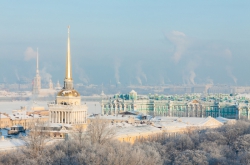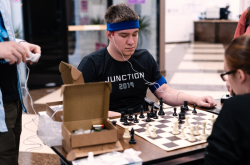Saskia Beer, an architect who once worked for well-known Dutch and Japanese companies, dedicated the last several years to researching the fundamentals of urban development and promoting her new approach to urban design. Her work didn't go unnoticed: the TransformCity project, an online platform for collaborative urban planning, got 2nd place at Le Monde International Smart Cities Innovation Awards 2016 and Call for Solutions award at the World Smart City Expo 2016 in Barcelona.
 Saskia Beer
Saskia Beer
She got the idea of the project back in 2011, when Amstel3, one of Amsterdam's districts, started to face the problem of ineffective use of office buildings. The district is deemed the city's 3rd in terms of economic growth. It is close to a highway and railroad, so it seems to be economically advanced; yet, at some point 30% of its population had difficulty finding a job, and then a problem with office buildings emerged. In 2011, about 200 square meters of office space was left empty. The city administration had neither resources, nor ideas for solving these problems.
"At that time, I lost my job as an architect, so I decided to contribute by solving this problem. I understood that it caused many architects to lose orders, so thinking about different models that could be used as solutions was an interesting thing to do. The buildings had many different owners, which was a good thing, as many people could collaborate on deciding on the ways to turn the situation to the better. Together with some of them, we addressed the government and asked to solve the problem in such a way that though the government would still play its role in the process, but the decisions would come bottom-up - i.e. from the participants of our collaborative process. I hoped that together, we will be able to create some model that will allow us to influence the administration by collaborating with it - and we've succeeded in doing that," shares the urban scientist.
The owners and tenants had nothing to lose, so they agreed to the proposal, hoping to gain at least something from it. The collaboration started with small meetings and events.

"I first wanted to make sure that what we do will bring results. I didn't have much money, or special approvals from the administration. So, I thought that we should start with founding a small company which can later turn into something bigger. Thus, in 2011 I started to ask more from other participants," explains Saskia Beer.
That meant they had to get closer and discuss particular topics that had to do with their common problem - those related to ecology, the district's nature and the like. During informal meetings, they discussed different ideas. Gradually, thanks to the increasing interest of the participants, more people started to learn about the project. The organizers created a database and communication channels for people to contact them.
"Between our own events, we had meetings with the administration's representatives who also proposed their solutions. In the end, our project grew, and more and more people became involved in its work. We understood that it's interesting. In the end, we've become a platform where discussion is always in process. It is an open dialog between representatives of administration, business, and common citizens. We started to offer the government representatives positions in our company, which helped us from the financial point of view," comments the expert.
At the informal meetings, the participants discussed the project's visualization. To understand what their results will look like, they mostly used Adobe Photoshop. As all of the participants were interested in the project's success, they gradually became partners and invested in new ideas. Thus, the district began to change: new cafes appeared in once empty buildings, and different art objects appeared on their walls. The more investments the project attracted, the livelier the district became.

In time, the organizers created a collective investment system. For instance, the city administration and other representatives invested into a special pavilion, which was to become a civic space. The locals also started to collect money for it; thus, though the pavilion was a temporary project, and the administration planned to use that space for a park later, the citizens persuaded them to leave the pavilion be.
By 2016, the platform's creators developed their prototype of a modernized territory - an interactive map that has information on every location in the district. The data for the map was provided by both owners and administration. What's more, the citizens also shared information, including energy consumption and the like - everything that could be of use for the purposes of urban planning.
"We've also created a timeline on our map - a sort of chronology, where anyone could see what has already been done and what we've planned, so that people could see our strategy and control the district's development. Different colors represent the project's progress. The platform is interactive, so anyone can click and see the information on any of the projects, comment on them, propose new ideas or vote for or against any of the existing ones."
 Transform City interactive map
Transform City interactive map
Despite the project's reliance on the citizen's initiatives, the administration still oversees its implementation. If its representatives see that an initiative is within the boundaries of legislation, its authors can continue with it; if it doesn’t comply with any safety regulations or other parameters, the idea becomes banned.
With time, the project turned to crowdfunding. Each time when some idea reached the stage of design, it became open to donations. As a result, citizens financed several projects at the same time. For instance, there was an area which the citizens avoided even though it was a shortcut to subway stations - the area was too dark at night and uncomfortable to walk through. The project succeeded in gathering 100,000 euros through crowdfunding for renovating it. As soon as the administration saw that people are really interested in it, they gave approval for the renovation.





